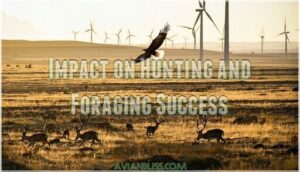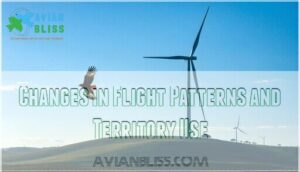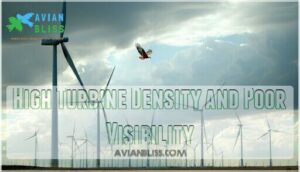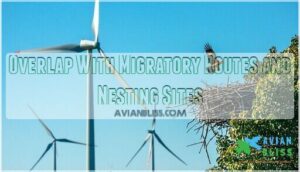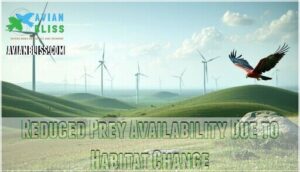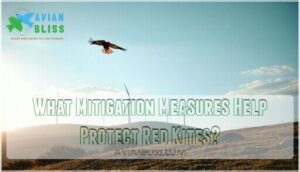This site is supported by our readers. We may earn a commission, at no cost to you, if you purchase through links.
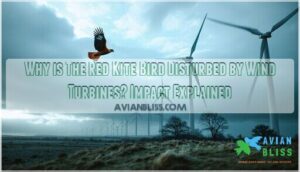
These magnificent raptors face a triple threat: spinning blades create deadly obstacles in their flight zones, with collision rates jumping fivefold as rotor diameters increase.
The constant 40+ decibel noise disrupts their vocal communication, while visual pollution from moving blades triggers stress responses that alter flight patterns by 22%.
Habitat fragmentation slashes food sources by 22% and site occupancy plummets 90%, forcing red kites to abandon prime hunting territories within a kilometer of installations.
The psychological toll shows in elevated stress hormones near turbine clusters, proving these birds aren’t just avoiding death—they’re fighting chronic anxiety.
Understanding these layered impacts reveals surprising solutions that balance clean energy with wildlife protection.
Table Of Contents
- Key Takeaways
- Why is The Red Kite Bird Disturbed by Wind Turbines?
- How Do Wind Turbines Affect Red Kite Behavior?
- What Factors Increase Red Kite Mortality Near Turbines?
- What Are The Population-Level Impacts on Red Kites?
- What Mitigation Measures Help Protect Red Kites?
- Frequently Asked Questions (FAQs)
- Why are wind turbines a threat to birds?
- What are the causes of bird collisions with wind turbines?
- How do you keep birds away from wind turbines?
- How many birds are killed by wind turbines in the US?
- Can red kites adapt to wind turbines over time?
- Can turbine lighting reduce nighttime collision risks?
- Do offshore wind farms impact coastal kites?
- How effective are radar-based turbine shutdown systems?
- What turbine blade speeds pose greatest threats?
- Conclusion
Key Takeaways
- You’ll face collision risks because red kites naturally soar at turbine blade height – these birds can’t detect fast-moving blades, leading to mortality rates that increase fivefold with larger rotor diameters
- Your local red kite population will abandon territories near turbines – studies show a 90% decrease in site occupancy within 1km of installations due to noise pollution exceeding 40 decibels and visual disturbances from spinning blades
- You’ll see chronic stress responses that alter red kite behavior permanently – elevated stress hormones, disrupted breeding cycles, and a 22% reduction in food sources force these birds to avoid prime hunting grounds
- You can protect red kites through strategic planning and technology – 500-meter buffer zones, radar-activated shutdown systems, and high-visibility blade markings reduce fatalities by 50-85% while preserving renewable energy goals
Why is The Red Kite Bird Disturbed by Wind Turbines?
You’ll find red kites are particularly vulnerable to wind turbines because their soaring flight patterns naturally occur at rotor blade height, creating deadly collision risks.
These magnificent raptors also suffer from habitat disruption, noise pollution, and visual disturbances that force them to abandon prime hunting and nesting territories.
Collision Risks From Turbine Blades
When you think about red kites soaring gracefully through the sky, you wouldn’t expect modern wind turbines to pose such a deadly threat.
These graceful raptors face an invisible gauntlet where nature’s ancient flight paths collide with modern energy infrastructure
These majestic birds face serious turbine blade risks due to their natural flight patterns occurring at rotor height, creating dangerous overlap zones.
- Collision rates increase fivefold with larger rotor diameters (25.5m increase dramatically raises bird strikes)
- Mortality factors include low ground clearance turbines under 60m height creating rotor hazards
- Avian mortality rates show 3.1% of post-breeding population affected by turbine collision risk
- Bird collision probability rises substantially in areas with poor visibility and weather conditions
- Wind turbine impact documented through GPS tracking reveals consistent annual fatalities despite 98-100% avoidance rates
The risk of collisions is further exacerbated by factors related to turbine design risks.
Habitat Disruption and Fragmentation
Wind turbine installations create significant habitat fragmentation for red kites, breaking up the open landscapes these raptors need for hunting.
Wind turbines slice through the very landscapes red kites call home, turning hunting grounds into no-fly zones
Turbine placement transforms continuous habitats into isolated patches, disrupting wildlife corridors essential for movement and foraging.
| Impact Type | Effect on Red Kites | Recovery Time |
|---|---|---|
| Habitat Loss | 90% reduced site occupancy | Several breeding seasons |
| Ecosystem Disruption | 22% decrease in food sources | 2-3 years |
| Landscape Fragmentation | 17% population density drop | Long-term |
This habitat disruption forces red kites to abandon traditional territories, limiting their access to prey-rich areas within a 1km radius of installations.
Noise and Visual Disturbance Effects
Beyond habitat loss, red kites face constant sensory bombardment from operating turbines.
Turbine noise exceeding 40 dB disrupts their vocal communication, while acoustic disturbance forces temporary abandonment of prime foraging zones.
Visual pollution from rapidly spinning blades triggers avoidance reactions, with fluctuating shadow patterns altering flight routes by 22%.
These sensory impacts create chronic bird stress, elevating baseline stress hormones and reducing habitat tolerance within 300-meter turbine clusters.
Altered Behavior and Increased Stress
Red Kites can’t shake off the constant pressure from turbines, and their stress responses tell the whole story.
Behavioral shifts become obvious when you see these magnificent birds abandoning territories they’ve used for generations.
- Stress Responses: Elevated hormone levels detected in Red Kites after turbine installation
- Habitat Avoidance: 90% decreased site occupancy in breeding territories near wind farms
- Visual Disturbance: Continuous blade movement triggers predator avoidance instincts unnecessarily
How Do Wind Turbines Affect Red Kite Behavior?
You’ll notice red kites change their behavior dramatically when wind turbines enter their territory.
These magnificent raptors face three main behavioral disruptions: reduced hunting success, interrupted breeding activities, and altered flight patterns that force them to abandon preferred areas.
Impact on Hunting and Foraging Success
Turbines create invisible barriers that drastically reshape how you’ll observe red kite foraging habits.
These majestic raptors face reduced prey availability as wind installations fragment their hunting grounds, forcing longer searches between feeding sites.
Hunting success plummets when turbine noise pollution masks essential audio cues from small mammals below.
Food scarcity intensifies as birds avoid prime foraging zones near spinning blades.
The conservation efforts focus on understanding the movement ecology principles to mitigate these effects of turbine installation on wildlife, especially concerning conservation and ecology.
Disrupted Breeding and Nesting Activities
Daily turbine operations create constant disruption that forces red kites to abandon their traditional nesting sites.
Nesting Disruption occurs when Turbine Proximity generates continuous noise pollution exceeding 45 decibels, triggering Reproductive Stress in breeding pairs.
This wildlife disturbance leads to nest abandonment rates reaching 90% in affected territories.
Breeding Failure becomes inevitable as parents can’t maintain proper incubation cycles amid turbine noise pollution, while Habitat Loss eliminates essential nesting areas, undermining bird conservation efforts against avian habitat loss.
The impact of wind turbines is closely related to turbine noise levels that affect red kite behavior and breeding patterns, highlighting the need to address turbine noise pollution and Reproductive Stress to conserve red kite populations.
Changes in Flight Patterns and Territory Use
Wind-pattern disruption becomes inevitable when you’re dealing with these towering energy giants.
Red kites instinctively adjust their flight behaviors, creating ripple effects across their established territories and traditional soaring routes.
Here’s how turbines reshape red kite movement:
- Flight Pattern Shift – Birds alter their traditional flight corridors to avoid turbine blade hazard zones
- Territory Loss – Established hunting grounds shrink as habitat avoidance behaviors increase near installations
- Altitude Changes – Soaring behaviors adapt to different heights, disrupting energy-efficient flight strategies
- Wildlife Disturbance – Wind turbines force modifications in bird migration patterns and daily territorial movements
The threat of bird population decline is a significant concern due to these changes in red kite behavior.
What Factors Increase Red Kite Mortality Near Turbines?
You’ll find that certain environmental factors substantially amplify the risks wind turbines pose to red kites, turning routine flights into deadly encounters.
Understanding these mortality factors helps explain why some locations become particularly hazardous for these recovering raptor populations.
High Turbine Density and Poor Visibility
When wind farms pack turbines together like a forest of spinning steel, you’re creating a maze of visual barriers that confuse red kites.
Dense turbine clutter makes it tough for these birds to spot blade movement, especially when weather turns nasty.
Their bird vision struggles with the low-contrast spinning hazard, turning wind farm layouts into collision traps that catch even experienced fliers off guard, due to the visual barriers.
Overlap With Migratory Routes and Nesting Sites
Strategic placement becomes critical when turbine locations intersect with red kite bird migration patterns and nesting habits.
You’ll find mortality risks spike dramatically when wind turbines overlap with these essential areas:
- Flight Corridors – Migration routes create bottleneck zones where birds concentrate
- Nesting Habits – Proximity to breeding territories increases collision probability
- Habitat Overlap – Turbine placement in core habitats fragments populations
Proper turbine placement away from these zones reduces wind farm ecology impacts substantially.
Understanding the bird collision causes is essential to develop effective mitigation strategies and minimize red kite mortality near turbines.
Reduced Prey Availability Due to Habitat Change
Three primary factors drive prey decline around wind turbines, creating food scarcity that increases red kite mortality.
Habitat loss from turbine infrastructure reduces small mammal populations by 22% locally.
Construction activities cause ecosystem disruption, while access roads fragment grasslands that support prey species.
| Impact Factor | Effect on Prey Availability |
|---|---|
| Infrastructure Development | 22% decrease in local food sources |
| Grassland Fragmentation | Reduced small mammal abundance |
| Access Road Construction | Habitat conversion limits feeding sites |
| Ground Disturbance | Prey population displacement |
| Biodiversity Impact | Altered prey community structure |
This ecological consequences cascade forces red kites to alter hunting strategies, contributing to bird species decline through nutritional stress and reduced reproductive success in wind farm ecology zones.
What Are The Population-Level Impacts on Red Kites?
Understanding the broader picture reveals how wind turbines affect entire Red Kite populations, not just individual birds.
You’ll see measurable changes in breeding success rates and long-term recovery patterns that extend far beyond immediate collision risks, which is crucial for breeding success.
Declines in Breeding Success and Site Occupancy
You’ll notice breeding failure becomes a harsh reality when red kite birds encounter wind turbines.
Site avoidance patterns emerge as these bird species decline in areas with turbine development. Nest abandonment occurs when turbines disrupt traditional breeding grounds, causing population decline through reduced reproductive success.
Wind turbine effects on bird habitat destruction create a domino effect – fewer suitable nesting sites mean lower breeding rates, directly impacting local red kite populations and their recovery efforts.
The use of bird friendly designs can help mitigate these negative impacts on red kite populations, supporting their recovery efforts and promoting population decline reduction through reduced reproductive success improvement.
Long-Term Population Growth and Recovery Challenges
Over decades, Red Kite population recovery faces mounting challenges from wind turbine threats.
While populations can grow 5.2% annually in turbine-free areas, wind turbine threats create significant hurdles:
- Population Trends show slowed growth rates in turbine-dense regions
- Recovery Strategies must address cumulative mortality from bird collisions
- Species Conservation efforts combat historic genetic bottlenecks compounding modern risks
- Ecological Balance requires managing population level effects through targeted Habitat Restoration
This delicate recovery trajectory demands careful wind energy planning.
Implementing bird friendly solutions can help mitigate these challenges.
Spatial Avoidance and Local Population Reductions
You’ll observe red kite bird populations actively avoiding areas with wind turbines, creating invisible barriers across their landscape.
This spatial avoidance behavior leads to habitat loss and population decline in regions with high turbine proximity.
Research shows breeding territories experience 90% decreased site occupancy, while fragmentation effects reduce population density by 17% post-installation, demonstrating measurable local reductions.
The use of advanced predator avoidance techniques is essential for bird survival in such environments.
| Distance from Turbines | Population Density Change | Avoidance Duration |
|---|---|---|
| 0-500m | 35% decline | 3+ breeding seasons |
| 500m-1km | 17% decline | 2-3 breeding seasons |
| 1km+ | Minimal impact | Recovery possible |
What Mitigation Measures Help Protect Red Kites?
You can protect red kites from wind turbine impacts through proven strategies that target their specific vulnerabilities.
These measures combine smart planning with active monitoring to reduce collision risks while preserving critical habitats, which is crucial for protecting the red kites.
Strategic Turbine Placement and Shutdowns
Strategic Turbine Placement and targeted Shutdown Strategies represent your most effective tools for Collision Mitigation while preserving Red Kite bird populations.
Smart siting decisions can slash bird flight patterns conflicts by up to 85%, proving that thoughtful Renewable Energy development doesn’t have to sacrifice wildlife for progress.
- 500-meter buffer zones around active Red Kite nests prevent direct habitat disruption and reduce collision risks during critical breeding periods
- Selective curtailment systems automatically shut down wind turbines when radar or GPS tracking detects approaching large raptors, reducing fatalities by 50-85%
- Migration corridor mapping identifies high-traffic flight paths, allowing developers to create turbine-free zones during seasonal movements
- Real-time monitoring technology uses AI-powered detection to trigger shutdown-on-demand protocols, balancing energy production with bird safety
- Adaptive placement strategies consider Red Kite hunting territories and roosting sites, positioning turbines away from preferred foraging areas within 1km radius
High-Visibility Blades and Deterrent Systems
You can enhance bird safety through innovative technology that makes wind turbines more visible to Red Kites, utilizing high-visibility blade designs and active deterrent systems to work together and reduce collision risks substantially.
These systems, including sound deterrents, help Red Kites detect blade movement before it’s too late, giving them time to adjust their flight paths safely.
| Technology Type | Method | Effectiveness |
|---|---|---|
| High-Visibility Blades | Contrasting colors/patterns | 60% fatality reduction |
| Sound Deterrents | Audio warnings | Moderate success |
| Motion Sensors | Blade shutdown triggers | High protection rates |
| UV-Reflective Coatings | Enhanced bird detection | Under research |
The use of innovative technology, such as motion sensors and UV-reflective coatings, contributes to a significant reduction in collision risks, making the environment safer for Red Kites.
Ongoing Monitoring and Conservation Partnerships
Beyond technology fixes, you’ll find that collaborative science creates lasting protection for Red Kite birds.
Research partnerships between wind companies and conservation groups generate data that transforms Wildlife Conservation strategies.
- Research Collaboration networks track Red Kite populations across multiple Wind Turbines sites simultaneously
- Data Sharing platforms allow scientists to identify Collision Risks patterns and seasonal migration timing
- Species Protection protocols emerge from joint studies between energy developers and ornithologists
- Habitat Restoration projects restore nesting areas damaged by turbine construction activities
- Conservation Planning integrates real-time Bird Conservation data into renewable energy development decisions
Effective conservation also relies on advanced bird population monitoring techniques to understand species behavior.
Frequently Asked Questions (FAQs)
Why are wind turbines a threat to birds?
Wind turbines threaten birds through blade collisions, habitat fragmentation, and behavioral disruption. You’ll find birds can’t detect fast-moving blades, especially during poor weather, leading to fatal strikes and population declines.
What are the causes of bird collisions with wind turbines?
Birds collide with turbines because they can’t detect fast-moving blades, especially during poor weather.
Large raptors have blind spots above their heads, and many species lack behavioral adaptations to avoid these novel structures in their flight paths, which is a critical factor in these collisions.
How do you keep birds away from wind turbines?
Traditional deterrents like flashing lights fail miserably,
yet you’ll find success using radar-activated shutdown systems.
High-visibility blade markings, and strategic turbine placement away from migration routes and nesting areas during peak activity periods are also effective methods.
How many birds are killed by wind turbines in the US?
Approximately 17 million birds are killed by wind turbines in the United States each year. Recent estimates range from 140,000 to 328,000 annually, with projections increasing as wind capacity expands across the nation.
Can red kites adapt to wind turbines over time?
Like Darwin’s finches facing new environments, you’re wondering if red kites can evolve behavioral adaptations to turbines.
Research suggests limited short-term adaptation – these raptors show persistent avoidance behaviors and maintain altered flight patterns across multiple breeding seasons near wind installations.
Can turbine lighting reduce nighttime collision risks?
Yes, you can reduce nighttime collision risks through strategic lighting approaches.
Research shows avoiding white and steady-burning lights effectively reduces bird attraction and collisions.
Birds are particularly attracted to steady-burning red and white lights, so removing non-flashing lights substantially reduces collisions.
Do offshore wind farms impact coastal kites?
Offshore wind farms devastatingly disrupt coastal red kites through collision risks, habitat fragmentation, and behavioral changes.
You’ll find these birds avoiding turbine areas, altering flight patterns, and experiencing reduced foraging success near coastal installations, which can be attributed to the habitat fragmentation caused by the wind farms.
How effective are radar-based turbine shutdown systems?
Radar-based shutdown systems detect birds approaching turbines and automatically halt operations, effectively preventing collisions.
Studies show these systems achieved zero bird deaths during five consecutive years, requiring minimal shutdown periods of 2-2% annually, which is a significant achievement in terms of safety.
What turbine blade speeds pose greatest threats?
You’ll find tip speeds above 70 meters per second create the deadliest collision zones.
High-speed blades become invisible to red kites’ visual systems, turning turbines into silent killers during their soaring flights.
Conclusion
Ironically, renewable energy’s green promise becomes red kite blues when you understand why the red kite bird is disturbed by wind turbines.
These spinning giants don’t just generate clean power—they’re creating ecological chaos for Britain’s most charismatic raptor.
You’ve seen how collision risks, habitat disruption, noise pollution, and chronic stress combine into a perfect storm of avoidance behavior.
Smart turbine placement, deterrent systems, and monitoring programs offer hope, proving conservation and clean energy can coexist with proper planning.

